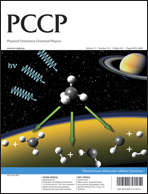Exact quantum reactive scattering calculations in the collision energy range 1–250 meV have been carried out for both the isotopic product channels of the title system. The dynamical studies compares an ab initio potential energy surface (PES) recently appeared in the literature (J. Chem. Phys., 2008, 129, 011103) with other phenomenological PESs. Vibrational branching ratios, cross sections and rate constants are presented and compared with molecular beam scattering experiments as well as with chemical kinetics data. In particular, the agreement of the vibrational branching ratios with experimental measurements is improved with respect to previous studies on other PESs, mainly because of the presence of a broad peak in the HF(v′ = 3) integral cross section completely absent in the previous simulations. This feature, observed by molecular beam experiments, is the fingerprint of a new reaction mechanism operative in the dynamics described by the new PES. A conjecture for its origin, able to explain many of its characteristic aspects, is analyzed and discussed.

You have access to this article
 Please wait while we load your content...
Something went wrong. Try again?
Please wait while we load your content...
Something went wrong. Try again?


 Please wait while we load your content...
Please wait while we load your content...